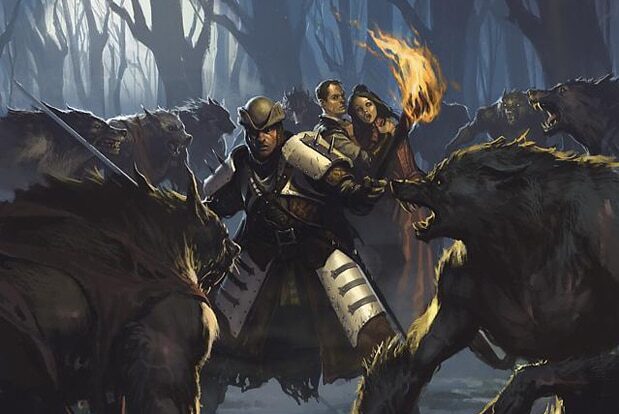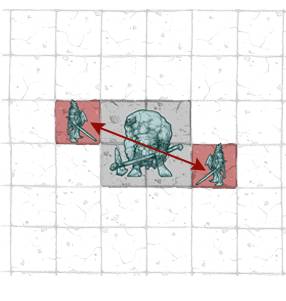Flanking in D&D 5e
Published on June 26, 2023
Master the art of Flanking in D&D 5e with our comprehensive guide. Learn tactics, understand rules, and gain the upper hand in your battles!

Table of Contents
Flanking in 5e: The Basics
Flanking in Dungeons & Dragons 5e is an optional rule presented in the Dungeon Master’s Guide that allows players to gain a strategic advantage in combat scenarios. It’s a tactical maneuver that can be used when two allies are positioned on opposite sides of an enemy.
According to the rule, which can be found in Chapter 8 of the DMG, when a creature and at least one of its allies are adjacent to an enemy and on opposite sides or corners of the enemy’s space, they are said to be flanking the enemy. When flanking, each of the allies gains advantage on melee attack rolls against that enemy.
However, it’s important to note that flanking is an optional rule, and the decision to use flanking in a game is entirely up to the Dungeon Master (DM). Some DMs might choose not to use it because it can overly complicate combat or make encounters too easy for the players. Others might choose to use it to add an extra layer of strategy and positioning to their combat encounters.
Flanking With a Grid
As it adds more tactics, strategy, and housekeeping to combat, flanking is most often used by groups playing with a battle map or virtual tabletop of some sort.
For a creature to be considered flanking, it must be adjacent to the enemy and on the opposite side or corner of the enemy’s space, along with at least one of its allies. This applies to both square and hexagonal grids. In cases of uncertainty on a grid, an imaginary line drawn between the centers of the creatures’ spaces can help determine if the enemy is flanked. If the line crosses through opposite sides or corners of the enemy’s space, the enemy is considered flanked.
On hexagonal grids, the number of hexes between the allies determines if they are flanking a Medium, Large, Huge, or Gargantuan creature. For Medium or smaller creatures, there should be 2 hexes between the allies. For Large creatures, there should be 4 hexes, for Huge creatures, 5 hexes, and for Gargantuan creatures, at least 6 hexes.
Flanking With Theatre of the Mind
Flanking can also be utilized in “Theatre of the Mind” style play, where combat and scenarios are described verbally without the use of a physical map or miniatures. However, it can be a bit more challenging to implement due to the abstract nature of positioning in this style of play.
In Theatre of the Mind combat, players would need to clearly state their intent to position themselves in a way that would allow for flanking. For example, a player might say, “I want to move around the ogre, to attack it from the opposite side as my ally.” It would then be up to the players and the DM to remember this information so the necessary bonuses can be applied.
When Can You Use Flanking?
Flanking can be utilized in any combat situation, as long as you and an ally are positioned correctly. It’s important to note that both you and your ally must be within 5 feet of the enemy and on opposite sides or corners of the enemy’s space. Your ally also must not be incapacitated in order to receive the bonus to your attacks.
It’s worth it to note that when a DM allows players to flank monsters in D&D, monsters can flank players right back. Pack animals or intelligent, tactical foes may employ this strategy to bring down a party’s tank, especially if they have a high armor class (AC).
Tips for Using Flanking
Avoid Opportunity Attacks. When you move around an enemy to get into a flanking position, be careful not to provoke an opportunity attack. If you leave an enemy’s reach during your move, they can use their reaction to make an opportunity attack against you.
Using Flanking Against High AC Opponents. Usually, enemies with high AC are meat bags without tons of movement options. If you can surround them and score extra hits thanks to advantage, it can make short work of even the toughest opponents.
Combine With Feats. The best flankers will be using the Sentinel feat. This allows you to make opportunity attacks, even if your quarry attempts to Disengage. Also, if you hit with your opportunity attack (which you should cause you’ll have advantage), the escaping creature’s can move for the rest of their turn. This is an awesome way to lock enemies in and take them down, as long as you have another martial buddy to help you out.
Grapple Your Foes. Another way to prevent an escape would be to grapple the foe you’re flanking, thus reducing their speed to zero unless they can break the grapple.
How Can You Counter Flanking?
So, you’ve got a DM that likes to get tactical with their players. Here are some ways to avoid being surrounded if you find yourself getting flanked time and time again in combat:
Get Out of Dodge. If you have a teleport ability, like misty step, you can easily avoid being surrounded by poofing out of there. Finding ways to get low-cost Disengages can help you slip out unharmed. The rogue’s Cunning Action allows you to Disengage as a bonus action, so you can use your movement and then Dash to get away from pursuers. Also, the Mobile feat can prevent enemies from getting opportunity attacks on you if you make an attack against them. It also bumps your speed, making it harder for enemies to catch up and surround you again.
Tank and Run. If you’re a frontline warrior without access to fancy magic or any additional ways to get out of combat, you could just take the opportunity attacks and run. Seeing as a creature can only make one attack as an opportunity attack, you could get out with a lot less damage than if you stick around to get wailed on by monsters with multiattacks. Their opportunity attacks would still be with advantage, so make sure you run before you’re in dire straits.
Focus Fire. It’ll be hard for enemies to flank you if you kill all their pals. Getting your party to focus fire on one of the flankers (hopefully the one going later in the initiative) could open up an opportunity where they kick the bucket before they can make use of their attacks with advantage. Another plus to this is it could leave the still-living flanker in an unstrategic position (AKA within reach of your raging barbarian party member). You could also have a caster friend try to incapacitate one of the flankers.
Flank the Tank
Flanking is a tactical aspect of D&D 5e that can turn the tide of a battle. Understanding the rules of flanking and how to use it effectively can make your combat encounters more dynamic and strategic. Hopefully, now that you’ve learned how advantageous flanking can be, you’ll incorporate it into your combat strategy!

